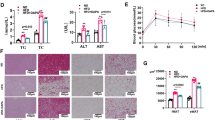Abstract
Recently, adipocytes have been shown to be recognized as endocrine cells that secrete a variety of bioactive substances known as adipocytokines. Among adipocytokines, adiponectin, a newly found adipose tissue-specific collagen-like protein, has been noted as an important antiatherogenic and antidiabetic protein. The function of adipocytes might be regulated dynamically by nutritional state. Visceral fat accumulation causes dysfunction of adipocytes and results in the development of a variety of metabolic and circulatory diseases through the abnormal secretion of adipocytokines. In this review, the importance of adipocytokines, including adiponectin, is discussed with respect to atherosclerosis.
Similar content being viewed by others
References and Recommended Reading
Matsuzawa YM: Pathophysiology and molecular mechanism of visceral fat syndrome: The Japanese case. Diabetes Metab Rev 1997, 13:3–13.
Shimomura I, Funahashi T, Takahashi M, et al.: Enhanced expression of PAI-1 in visceral fat: possible contribution to vascular disease in obesity. Nature Med 1996, 2:1–5.
Lindsay RS, Funahashi T, Hanson RL, et al.: Adiponectin and development of type 2 diabetes in the Pima Indian population. Lancet 2002, 360:57–58.
Ouchi N, Kihara S, Arita Y, et al.: Novel modulator for endothelial adhesion molecules: adipocyte-derived plasma protein. Circulation 1999, 100:2473–2476.
Okamoto Y, Kihara S, Ouchi N, et al.: Adiponectin reduces atherosclerosis in apolipoprotein E-deficient mice. Circulation 2002, 26:2767–2770.
Kumada M, Kihara S, Sumitsuji S, et al.: Association of hypoadiponectinemia with coronary artery disease in men. Arterioscler Thromb Vasc Biol 2003, 23:85–89.
Shimomura I, Hammer RE, Ikemoto S, et al.: Leptin reverses insulin resistance and diabetes mellitus in mice with congenital lipodystrophy. Nature 1999, 401:73–76.
Uysal KT, Wiesblock SM, Mario MW, Hotamisligil GS: Protection from obesity-induced insulin resistance in mice lacking TNF-alpha function. Nature 1997, 389:610–614.
Steppan CM, Bailey ST, Bhat S, et al.: The hormone resistin links obesity to diabetes. Nature 2001, 409:307–312.
Matsuzawa YM, Funahashi T, Kihara S, Shimomura I: Adioinectin and metabolic syndrome. Arterioscler Thromb Vasc Med 2004, 24:29–34.
Author information
Authors and Affiliations
Rights and permissions
About this article
Cite this article
Matsuzawa, Y. Adipocytokines: Emerging therapeutic targets. Curr Atheroscler Rep 7, 58–62 (2005). https://doi.org/10.1007/s11883-005-0076-3
Issue Date:
DOI: https://doi.org/10.1007/s11883-005-0076-3




